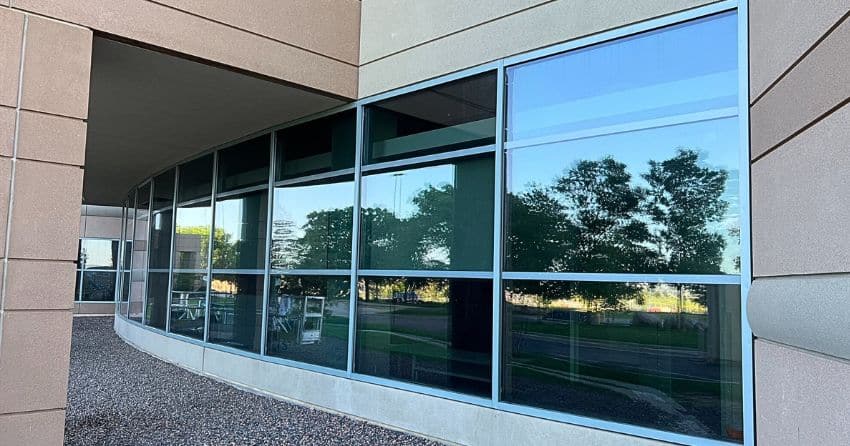How Secondary Glazing Retrofitting Improves Energy Efficiency for Adaptive Reuse and Existing Building Upgrades

- What is Secondary Glazing?
- Key characteristics of secondary glazing
- Adaptive Reuse vs. Renovation Project Designs
- Code Compliance and Risk Mitigation
- Designing for Preservation and Performance
- Design benefits
- Architectural Perspectives on Retrofit Glazing
- Architectural benefits
- Facility Management and Operational Benefits
- Operational benefits
- Cost Effectiveness and Long-Term Value
- Reducing Embodied Carbon in Renovation and Reuse
- How secondary glazing reduces embodied carbon
- LEED Alignment and Performance Standards
- Potential LEED credit contributions
- Case Applications in Adaptive Reuse and Facility Upgrades
- Educational facilities
- Government and municipal buildings
- Retail and commercial spaces
- Healthcare environments
- Specifying Secondary Glazing: Design and Implementation Considerations
- Key considerations
- Smart Building Integration and Digital Monitoring
- Tenant Experience and Occupant Well-Being
- Top 10 Unexpected Benefits of Secondary Glazing
- Enhanced Security and Forced Entry Resistance
- Seasonal Performance Flexibility
- Condensation Control
- Preservation of Fragile or Valuable Frames
- Faster Approvals in Historic Properties
- Acoustic Enhancement in Sensitive Spaces
- UV Protection and Asset Longevity
- Potential for Insurance Incentives
- Improved Thermal Zoning and System Optimization
- Supports Grant Eligibility and Green Financing
As the demand for low-carbon design grows, project teams are turning to retrofit strategies that enhance performance without sacrificing aesthetics. One strategy gaining momentum is secondary glazing—a non-invasive solution that improves thermal and acoustic performance in existing buildings.
Secondary glazing is especially useful in occupied or historically significant buildings where major changes are not feasible. This solution allows architects and facility managers to meet energy and comfort goals while preserving design integrity. It’s ideal for revitalizing historic properties or updating aging office spaces without disruptive demolition.
Secondary glazing bridges preservation and performance, aligning buildings with modern standards of sustainability, wellness, and operational efficiency. Its appeal lies in its flexibility, efficiency, and unobtrusive design.
What is Secondary Glazing?
Secondary glazing involves the installation of an internal glazing layer mounted on the interior side of existing windows. These layers are typically glass, acrylic, or polycarbonate.
Unlike full window replacement, secondary glazing retains the primary window while improving performance from the inside out.
Key characteristics of secondary glazing include:
- Interior-mounted solution, preserving the original exterior
- Customizable to various frame shapes, sizes, and sightlines
- Available in fixed, sliding, or removable formats
- Suitable for both historic and modern structures
- Compatible with glass, acrylic, and polycarbonate glazing
Retrofit glazing systems are also available to mount on the exterior of existing windows, doors, and curtain wall systems.
This approach is especially well-suited to properties with protected exteriors, where regulatory or aesthetic requirements prohibit exterior alterations. It’s also a practical solution for occupied buildings, as installation is typically quick, non-disruptive, and clean.
Adaptive Reuse vs. Renovation Project Designs
Understanding the distinction between adaptive reuse and traditional renovation is essential when specifying retrofit strategies like secondary glazing.
- Adaptive reuse refers to the process of repurposing an existing building for a use other than its original design. Examples include converting a post office into a public library or transforming an old factory into apartments.
- Renovation, by contrast, generally involves updating or restoring a building for its current or original function. Examples include modernizing HVAC systems or replacing finishes in a decades-old hospital.
In both contexts, project teams must often balance energy goals with structural limitations and preservation mandates. Secondary glazing offers a solution that serves both adaptive reuse and renovation objectives without requiring demolition or new framing systems.
Code Compliance and Risk Mitigation
As energy codes and emissions targets grow stricter, secondary glazing helps buildings comply without major renovations. It improves U-values and airtightness to meet evolving standards, sometimes avoiding penalties for non-compliance.
Depending on material choice, it can also contribute to impact resistance and fire safety goals. This added layer of performance reduces risk and supports regulatory planning.
Designing for Preservation and Performance
Retaining architectural character is a common priority in both historic and design-conscious projects. However, aging windows often underperform in terms of insulation, acoustics, and air leakage.
Secondary glazing enables teams to retain the visual and material integrity of original fenestration while delivering measurable performance improvements.
Design benefits include:
- Thermal insulation upgrades without altering existing frames
- Enhanced occupant comfort through draft and condensation control
- Support for passive heating and cooling strategies
- Visual continuity with original materials and proportions
This makes secondary glazing ideal for preservation zones, registered landmarks, and design-led renovations where window replacements are not ideal. It eliminates aesthetic disruption and concerns over code violations.
Architectural Perspectives on Retrofit Glazing
From an architect’s standpoint, secondary glazing offers rare flexibility in balancing performance with intent. Because it mounts internally, it’s invisible from the street—allowing teams to deliver modern-day energy standards without compromising external façades.
Architectural benefits cited in practice include:
- Simplified detailing and integration with heritage interiors
- Reduced solar glare in highly glazed elevations
- Improved acoustic insulation in urban and mixed-use contexts
- Support for WELL Building Standard goals related to occupant comfort
A growing number of architects view secondary glazing as a critical tool in designing adaptive reuse projects that align with environmental targets. Its use is not merely functional but also strategic in creating resilient, efficient, future-ready spaces.
Facility Management and Operational Benefits
Facility managers working on aging buildings—particularly those built before the 1980s—face a litany of performance challenges. Among these are rising energy bills, poor thermal comfort, and maintenance-heavy windows.
Secondary glazing addresses these issues while sidestepping the high cost and disruption of full window replacement.
Operational benefits include:
- Lower HVAC loads due to improved U-values
- Better internal climate regulation with minimal manual intervention
- Decreased maintenance demands on original window components
- Enhanced tenant satisfaction in commercial and institutional settings
One major advantage of secondary glazing is that it can be installed while the building remains fully operational. This reduces disruption, avoids downtime, and prevents lost revenue—especially important in hospitals, schools, and hotels.
Installations are fast, clean, and performed from the interior. No scaffolding or loud equipment is usually required. This makes it ideal for sensitive environments where quiet, safety, and access are top priorities.
Shorter timelines help teams realize energy benefits quickly while maintaining occupancy.
Cost Effectiveness and Long-Term Value
Secondary glazing delivers strong ROI by combining lower upfront costs with lasting operational savings. It’s often far more affordable than full window replacement, especially for large or complex buildings.
Energy savings, reduced HVAC load, and minimal upkeep result in lower lifecycle costs. For budget-conscious projects or phased upgrades, secondary glazing is a smart choice.
It also supports tenant retention by improving comfort and appearance—key drivers in leasing decisions.
Reducing Embodied Carbon in Renovation and Reuse
One of the most overlooked benefits of secondary glazing is its low embodied carbon. Because it retains the existing window structure, it avoids the carbon-intensive process associated with full window replacement.
In terms of embodied carbon, secondary glazing contributes to:
- Reduced emissions from avoided material manufacturing
- Lower transportation-related emissions
- Extended lifespan of existing building components
- Whole-building carbon reduction strategies
Lifecycle analysis models increasingly prioritize retrofit over replacement due to its carbon efficiency. In adaptive reuse, this distinction becomes even more valuable, allowing teams to meet performance goals while minimizing their environmental impact.
LEED Alignment and Performance Standards
For projects pursuing LEED certification or other high-performance building standards, secondary glazing can support multiple credit categories. Its ability to enhance thermal comfort, daylight control, and energy performance aligns with the objectives of both new construction and existing building rating systems.
Potential LEED credit contributions include:
- Energy & Atmosphere (EA): Reduced heating and cooling demand
- Indoor Environmental Quality (EQ): Improved acoustic performance and thermal comfort
- Materials & Resources (MR): Reuse of existing components to lower embodied carbon
- Innovation (IN): Use of advanced, invisible retrofit technology
Case Applications in Adaptive Reuse and Facility Upgrades
Secondary glazing has been successfully used in a range of adaptive reuse and renovation projects, including:
Educational facilities:
- Historic school buildings upgraded for thermal and acoustic comfort
- Preserved window designs meet district-wide sustainability goals
Government and municipal buildings:
- Courthouses and city halls maintain their original character while reducing HVAC loads
- Internal installations avoid permitting issues common in landmark properties
Retail and commercial spaces:
- Urban storefronts and historic warehouses adapted into office or co-working spaces
- Glare and sound control enhances employee productivity and wellness
Healthcare environments:
- Hospitals and care centers reduce drafts, dust infiltration, and exterior noise
- Enhanced patient experience without disrupting day-to-day operations
These examples illustrate how secondary glazing adapts to the demands of both design teams and building operators across diverse sectors.
Specifying Secondary Glazing: Design and Implementation Considerations
For project teams evaluating secondary glazing, a holistic specification process ensures optimal results.
Key considerations include:
- Assessment of existing window conditions to determine compatibility and potential air gaps
- Framing systems and mounting hardware designed to complement interior aesthetics
- Glazing material selection based on performance priorities (e.g., polycarbonate for impact resistance, low-E glass for thermal control)
- HVAC and lighting integration, particularly where interior shading or daylight control strategies are employed
- Installer qualifications to ensure accurate measurement, sealant performance, and long-term durability
Early collaboration between architects, engineers, and facility managers helps streamline installation and prevent downstream conflicts in building systems.
Smart Building Integration and Digital Monitoring
As building systems grow smarter, secondary glazing can be integrated with performance monitoring platforms to support energy and asset management. It enables facility teams to track performance, adjust HVAC settings, and respond to real-time data in complex building environments.
Smart sensors and building automation benefit from more stable interior conditions and reduced energy waste driven by secondary glazing. This pairing supports long-term energy efficiency planning and offers a measurable return on investment for commercial and institutional properties.
Secondary glazing also helps meet disclosure mandates and ESG reporting goals through verifiable performance upgrades in retrofitted buildings.
Tenant Experience and Occupant Well-Being
Beyond technical performance, secondary glazing improves daily experiences for building occupants—tenants, guests, employees, and students. It reduces noise, minimizes drafts, and supports stable indoor temperatures, contributing to improved health, focus, and satisfaction.
These benefits are especially valuable in schools, hospitals, apartments, and hotels where comfort drives engagement and long-term value. Secondary glazing enhances both space quality and human experience, aligning facility design with wellness and productivity goals.
It’s not just an energy solution—it’s a people-first investment in performance and livability.
Top 10 Unexpected Benefits of Secondary Glazing
While energy efficiency and design preservation are core drivers, secondary glazing offers a wide range of lesser-known advantages. These benefits extend beyond performance metrics and support broader operational, financial, and preservation goals.
1. Enhanced Security and Forced Entry Resistance
Secondary glazing provides an additional physical barrier that discourages intrusion. When paired with laminated glass or polycarbonate panels, it increases resistance to break-ins and vandalism. This is especially beneficial in retail, educational, and government settings.
2. Seasonal Performance Flexibility
It delivers year-round efficiency. In winter, it minimizes heat loss and drafts. In summer, low-emissivity or solar control coatings reduce heat gain, improving comfort and reducing HVAC demand in all climates.
3. Condensation Control
By stabilizing the interior surface temperature of the original window, secondary glazing significantly reduces condensation. This supports visibility, prevents mold formation, and protects window frames from moisture damage.
4. Preservation of Fragile or Valuable Frames
In historic buildings, original windows may be fragile or irreplaceable. Secondary glazing protects these assets by reducing physical contact, limiting air exposure, and eliminating the need for structural removal.
5. Faster Approvals in Historic Properties
Because secondary glazing is discreet and does not alter the building’s external appearance, it often receives faster approval from historic preservation authorities. This helps avoid project delays and maintains compliance.
6. Acoustic Enhancement in Sensitive Spaces
Beyond general noise reduction, secondary glazing supports acoustic control in environments where sound clarity matters. This has tremendous customer enhancement possibilities for libraries, performance halls, healthcare facilities, and recording studios, and more.
7. UV Protection and Asset Longevity
UV-filtering secondary panels help protect furniture, flooring, artworks, and finishes from fading or degradation. This is especially valuable in museums, heritage interiors, and commercial spaces with expensive fixtures.
8. Potential for Insurance Incentives
In certain commercial or institutional settings, upgrades that improve building security or envelope resilience may contribute to reduced insurance premiums. Secondary glazing can help qualify for such incentives, as well as other tax benefits.
9. Improved Thermal Zoning and System Optimization
By reducing perimeter heat loss or gain, secondary glazing can help HVAC systems operate more efficiently and maintain thermal zoning. This is especially important in large or multi-use floorplans.
10. Supports Grant Eligibility and Green Financing
Because it reduces energy use and embodied carbon without compromising historic integrity, secondary glazing can help projects qualify for preservation grants, energy rebates, or green financing programs.
In Summary
Secondary glazing presents a strategic opportunity to enhance building performance while preserving architectural intent, controlling costs, and minimizing operational disruption. As cities prioritize decarbonization and adaptive reuse emerges as a preferred development strategy, secondary glazing delivers outsized value.
Its quick, non-invasive installation supports continuity in occupied buildings, helping teams avoid costly downtime. When integrated with smart building systems, it provides measurable energy insights and strengthens long-term sustainability planning.
By improving thermal comfort, controlling noise, and supporting daylight and condensation management, secondary glazing enhances the daily experience of building occupants—whether in classrooms, offices, healthcare settings, or multifamily housing.
In addition to its well-established energy and preservation benefits, secondary glazing offers unexpected advantages: improved security, UV protection, acoustic refinement, potential insurance savings, and eligibility for grants and green financing.
Together, these benefits empower architects, engineers, and facility managers. Retrofitting is not a compromise—but as a high-performance, low-disruption solution that delivers comfort, compliance, and long-term value.
Contact DefenseLite to schedule a consultation and explore retrofit solutions tailored to your next project.


